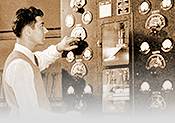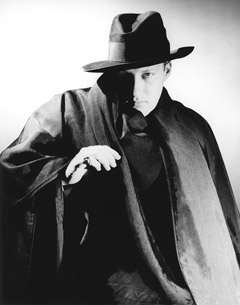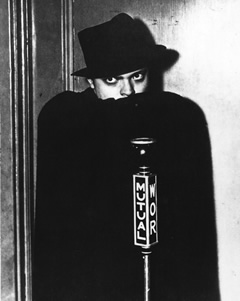



|
 |
FEATURED ARTICLE
THE SHADOW:
MYSTERY MAN OF THE CENTURY
By Elizabeth McLeod
The following article is presented in celebration of the 81st anniversary of the radio premiere of The Shadow on July 31st.
"Who knows what evil lurks in the hearts of men?" For most of the latter two-thirds of the twentieth century, just about everyone knew that question -- and its answer. From the 1930s into the 1990s, "The Shadow" cast a substantial shadow over American popular culture -- such that even those who had never actually listened to any of his radio adventures, read any of his pulp novels, or seen any of his movie appearances, had at least some awareness of the character. Of all the American pop-culture figures of the century, only Tarzan, Superman, and the Lone Ranger could be said to have attained this level of recognition.

Bret Morrison as The Shadow
|
But why? What made this character so memorable? How did the hero of a low-budget Sunday afternoon melodrama attain such stature in our collective psyche? What made The Shadow special to those who heard him in his original broadcasts -- and those who've heard him in reruns in the decades since?
The Shadow didn't even start out as "The Shadow," at least not as the familiar Lamont Cranston with the power to cloud men's minds. While that character owed much to the cloak-and-mask mystery-man figures of the 1920s pulp magazine world, radio's original Shadow emerged from a far different tradition -- the omniscient host-narrator.
Radio drama in the late 1920s was dominated by anthology formats -- programs that offered a new story with new characters each week. The common thread throughout these series would be provided by a narrator -- a recognizable personality who gave the program consistency and provided a recognizable hook for listener interest. These figures were usually presented as avuncular older men -- The Old Ranger of the California desert, The Old Timer of the Great Northern Railroad, Old Forty-Fathom the globe-trotting sea captain. But, occasionally, these narrator figures would take on a more sinister guise, and The Shadow a prime example. Each week, The Shadow would provide a grim-voiced introduction to the Street and Smith Detective Story program. He was not specifically defined as a character, he didn't interact with the participants in the story, but he did give the program an unmistakable signature in his weekly opening. Cackling into a tipped drinking glass to create a hollow, mysterious effect, actor Frank Readick (the best-known of the early Shadows) riveted the listener's attention right from the opening seconds of each week's episode. In the chaotic world of Depression-era radio, where fads and trends came and went by the week, such a recognizable signature was invaluable in creating an enduring brand. The stories themselves have long since slipped into oblivion, but the Shadow himself would endure.
Street and Smith Publications were quick to build a very successful business on The Shadows successful brand -- hurrying to meet the demand for a magazine based on their unexpectedly-popular radio character. But the adventures of an omniscient narrator didn't seem quite the thing for the printed page. Who was the Shadow, anyway? How did he happen to know what evil lurked in the hearts of men? These were questions his radio listeners wanted answered, and the answers were just the stuff of which great pulp fiction was made. When author Walter Gibson created a definitive mythos around the idea of "The Shadow," the ingredients for a legendary character came together. Kent Allard, alias Lamont Cranston, alias the Shadow was the mysterious leader of a world-wide organization of crime-fighters, the possessor of arcane secrets of psychology, and master of the latest techniques in scientific criminology.
But on the radio, the Shadow remained for some time a mysterious narrator, content to tell other people's stories. Listeners began to demand that the magazine Shadow appear on the air. Street and Smith began to demand the same. However, The Shadows radio sponsor, Blue Coal, was reluctant to tamper with success. This led to the eventual demise of the original series in 1935. Street and Smith set immediately to work on a new radio program incorporating Gibson's magazine character. Before the end of the year, a syndicated 15-minute serial was produced on the West Coast with actor Carl Kroenke as Lamont Cranston. Although it failed to stand out significantly from the dozens of quarter-hour mystery programs then making the rounds of the transcription markets, it was successful enough to convince Street and Smith that Lamont Cranston was a viable radio property.
Blue Coal finally agreed as well and, in the fall of 1937, a revamped Shadow series premiered over the Mutual network. The new show featured a somewhat condensed version of the Gibson mythos, and featured an organ-voiced young stage actor named Orson Welles in the title role. It was this series that would define The Shadow forever after.

Orson Welles as The Shadow
|
In 1937, Welles was a 22 year old theatrical prodigy, about to set New York astorm with his provocative modern-dress production of Julius Caesar. But, experimental theatre was hardly a moneymaker, and the youthful producer was forced to earn his bread and butter in the radio studios as one of the many versatile-but-anonymous bit actors who filled roles wherever they could get them. He had drawn attention to himself in 1936 with an audacious cut-down version of Hamlet over CBS, and rode that publicity into a seven-week dramatization of Les Miserables over Mutual in the summer of 1937. His heart was in finding new ways to bring the classics to astonished audiences, but he was quite willing to do more proletarian work if it paid well. While never viewing The Shadow as anything more than a slightly embarrassing weekly paycheck, Welles nonetheless gave Lamont Cranston an air of insouciance, and his Shadow alter ego a sense of sardonic menace, that captivated listeners. Although, like all Welles characterizations, Cranston could be something of a pompous blowhard at times (especially when pedantically explaining the facts of a case to the long-suffering Margo Lane), he nonetheless stood out as an adventure character of distinction -- a hero who fought with his brains as often as he did with his fists.
This made The Shadow an ideal program for family listening. And, given its just-before-Sunday-dinner time slot, this was clearly the target audience. There was just enough blood-and-thunder to keep the kids happy, combined with just enough semi-intellectual rationalization to keep parents from twisting the dial to something quieter. For as long as The Shadow continued on the air, and no matter who played him -- from Bill Johnstone to Steve Courtleigh to John Archer to Bret Morrison -- this would be the formula, and the audience couldn't get enough of it. Never mind that the plots tended to repeat themselves with alarming frequency, The Shadow fought his mad scientists and bitter crime lords with style.
Dramatic radio died a slow, painful death over the course of the 1950s, and Lamont Cranston was one of its casualties -- fading into the static in 1954. However, syndication entrepreneur Charles Michaelson soon snatched him out of oblivion and ensured his immortality. Michaelson had been involved with the series as a secondary-market distributor since the late 1930s, and when the program ended its network run he found himself sitting on a large stack of transcriptions. In the early 1960s, he dusted these off and began offering them around -- suspecting that listeners who had grown up on The Shadow might just like to hear him on the air again.
Michaelson's instincts were correct, and when the nostalgia wave of the early 1970s hit, The Shadow rode it back to its own special cultural niche. Whether it was middle-aged nostalgics fondly remembering the thrilling Sunday afternoons of their youth, smug collegians looking for a dose of high camp, or even a new generation of kids stumbling across a scratchy rerun on a transistor radio in the middle of the night, The Shadow's lure remained potent. Even as late as the 1990s, the character remained recognizable enough, and marketable enough, to power a big-budget Hollywood film. Alec Baldwin was no Orson Welles, but he kept the franchise alive into its sixth decade.
Now, more than a decade into the 21st Century, the Shadow is perhaps not quite so recognizable. Fewer people on the street know who knows what evil lurks in the hearts of men. But, the power of the character is still there -- and presented properly, at the right moment, to a receptive audience, there's every reason to expect The Shadow to emerge again someday, ready to assume his place on our pop-culture stage.
Copyright 2011 Elizabeth McLeod and RSPT LLC. All rights reserved.
May not be reproduced without permission.
|
|


